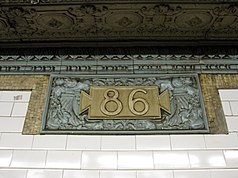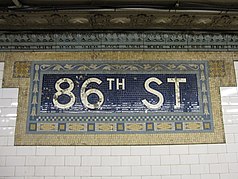86th Street station (IRT Broadway–Seventh Avenue Line)
86 Street | ||||||||||||||||||||||||||||||||||||||||||||||||||||||||||||||||||||
|---|---|---|---|---|---|---|---|---|---|---|---|---|---|---|---|---|---|---|---|---|---|---|---|---|---|---|---|---|---|---|---|---|---|---|---|---|---|---|---|---|---|---|---|---|---|---|---|---|---|---|---|---|---|---|---|---|---|---|---|---|---|---|---|---|---|---|---|---|
| Structure | Underground | |||||||||||||||||||||||||||||||||||||||||||||||||||||||||||||||||||
| Platforms | 2 side platforms | |||||||||||||||||||||||||||||||||||||||||||||||||||||||||||||||||||
| Tracks | 4 | |||||||||||||||||||||||||||||||||||||||||||||||||||||||||||||||||||
| Other information | ||||||||||||||||||||||||||||||||||||||||||||||||||||||||||||||||||||
| Opened | October 27, 1904[4] | |||||||||||||||||||||||||||||||||||||||||||||||||||||||||||||||||||
| Opposite- direction transfer | No | |||||||||||||||||||||||||||||||||||||||||||||||||||||||||||||||||||
| Traffic | ||||||||||||||||||||||||||||||||||||||||||||||||||||||||||||||||||||
| 2023 | 3,983,729[5] | |||||||||||||||||||||||||||||||||||||||||||||||||||||||||||||||||||
| Rank | 74 out of 423[5] | |||||||||||||||||||||||||||||||||||||||||||||||||||||||||||||||||||
| ||||||||||||||||||||||||||||||||||||||||||||||||||||||||||||||||||||
| ||||||||||||||||||||||||||||||||||||||||||||||||||||||||||||||||||||
| ||||||||||||||||||||||||||||||||||||||||||||||||||||||||||||||||||||
| ||||||||||||||||||||||||||||||||||||||||||||||||||||||||||||||||||||
| ||||||||||||||||||||||||||||||||||||||||||||||||||||||||||||||||||||
| ||||||||||||||||||||||||||||||||||||||||||||||||||||||||||||||||||||
The 86th Street station is a local station on the IRT Broadway–Seventh Avenue Line of the New York City Subway. Located at the intersection of West 86th Street and Broadway on the Upper West Side of Manhattan, it is served by the 1 train at all times and the 2 train during late nights.
The 86th Street station was constructed for the Interborough Rapid Transit Company (IRT) as part of the city's first subway line, which was approved in 1900. Construction of the line segment that includes the 86th Street station began on August 22 of the same year. The station opened on October 27, 1904, as one of the original 28 stations of the New York City Subway. The station's platforms have been lengthened since opening.
The 86th Street station contains two
History
Construction and opening
Planning for a subway line in New York City dates to 1864.[7]: 21 However, development of what would become the city's first subway line did not start until 1894, when the New York State Legislature passed the Rapid Transit Act.[7]: 139–140 The subway plans were drawn up by a team of engineers led by William Barclay Parsons, the Rapid Transit Commission's chief engineer. It called for a subway line from New York City Hall in lower Manhattan to the Upper West Side, where two branches would lead north into the Bronx.[8]: 3 A plan was formally adopted in 1897,[7]: 148 and all legal conflicts concerning the route alignment were resolved near the end of 1899.[7]: 161
The Rapid Transit Construction Company, organized by John B. McDonald and funded by August Belmont Jr., signed the initial Contract 1 with the Rapid Transit Commission in February 1900,[9] under which it would construct the subway and maintain a 50-year operating lease from the opening of the line.[7]: 165 In 1901, the firm of Heins & LaFarge was hired to design the underground stations.[8]: 4 Belmont incorporated the Interborough Rapid Transit Company (IRT) in April 1902 to operate the subway.[7]: 182
The 86th Street station was constructed as part of the IRT's West Side Line (now the
: 186Service changes and station renovations
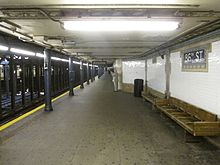
After the first subway line was completed in 1908,
To address overcrowding, in 1909, the
In December 1922, the Transit Commission approved a $3 million project to lengthen platforms at 14 local stations along the original IRT line, including 86th Street and five other stations on the Broadway–Seventh Avenue Line. Platform lengths at these stations would be increased from 225 to 436 feet (69 to 133 m).[16][17] The commission postponed the platform-lengthening project in September 1923, at which point the cost had risen to $5.6 million.[18][19] In 1927, an additional staircase was constructed from the uptown platform to the northeastern corner of 86th Street and Broadway by Patteli & Wilson for $25,300.[20][21] In 1932, the entrance at the southeastern corner of 86th Street and Broadway was relocated from the easterly curb of Broadway to the southern building line of 86th Street. The new entrance did not have a kiosk.[22]
The city government took over the IRT's operations on June 12, 1940.
The original IRT stations north of Times Square could barely fit local trains of five or six cars depending on the configuration of the trains. Stations on the line from 50th Street to 96th Street, including this station but excluding the 91st Street station, had their platforms extended in the 1950s to accommodate ten-car trains as part of a $100 million rebuilding program.[27] The contract to extend the platforms at 79th Street and 86th Street was awarded to Delma Engineering Corporation for $1,867,705 in 1957 (equivalent to $20,262,000 in 2023).[28] The platform extensions at the local stations were completed by early 1958.[27] As part of the contract to extend the platform at this station, additional entrances were constructed.[29]
Once the project was completed, all 1 trains became local and all 2 and 3 trains became express, and eight-car local trains began operation. Increased and lengthened service was implemented during peak hours on the 1 train on February 6, 1959.[30] Due to the lengthening of the platforms at 86th Street and 96th Street, the intermediate 91st Street station was closed on February 2, 1959, because it was too close to the other two stations.[31][27]
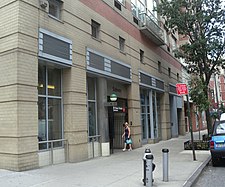
In 1985, art and mosaics were installed in the station for $200,000 (equivalent to $567,000 in 2023). The cost was covered by Haines, and was done as part of the construction of The Bromely at 85th Street and Broadway. The following year, the entrance to the southwestern corner of 87th Street and Broadway was relocated into a building, The Boulevard at 246 West 87th Street. The $1,270,000 cost of the project (equivalent to $3,598,000 in 2023) was borne by the developer, Eichner. The entrance was constructed to supplant public infrastructure improvements required by the New York City Housing Quality Program for the construction of The Boulevard, which in turn allowed the developer to increase the height of the development.[32][33]
In April 1988,
Station layout
| Ground | Street level | Exit/entrance |
| Platform level | Side platform | |
| Northbound local | ← ← | |
| Northbound express | ← | |
| Southbound express | | |
| Southbound local | | |
| Side platform | ||
Like other local stations, 86th Street has four tracks and two
Design
As with other stations built as part of the original IRT, the station was constructed using a
This station retains original mosaic and terracotta wall reliefs, consisting of purple characters surrounded by yellow and blue tiles. The tiled pilasters on the side walls are interrupted by tiled rectangles, as well as motifs of little squares and semicircles.[48] The decorations also include cornucopia designs with the number "86". There are also a few "Men" and "Women" relief signs for now-defunct restrooms.[46]: 37 The mosaic tiles at all original IRT stations were manufactured by the American Encaustic Tile Company, which subcontracted the installations at each station.[46]: 31 The decorative work was performed by tile contractor Alfred Boote Company and faience contractor Rookwood Pottery Company.[46]: 37 The ceilings of the original platforms and fare control areas contain plaster molding.[46]: 10 At the northern part of the station, where the platforms have been extended, the walls have cream-colored tiles with a pink trim line and black "86th ST" written on them at regular intervals.[49]
The 86th Street station has artwork installed in 1989 entitled Westside Views by
Exits
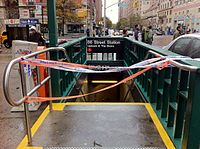
All
The southbound platform has another fare control near the north end. A bank of three turnstiles lead to a token booth that is only staffed during rush hours. A staircase goes up to an alcove inside 246 West 87th Street, on the southwest corner of West 87th Street and Broadway.[53]
References
- ^ "Borough of Manhattan, New York City". Government of New York City. Archived from the original on January 7, 2021. Retrieved December 28, 2020.
- ^ "Glossary". Second Avenue Subway Supplemental Draft Environmental Impact Statement (SDEIS) (PDF). Vol. 1. Metropolitan Transportation Authority. March 4, 2003. pp. 1–2. Archived from the original (PDF) on February 26, 2021. Retrieved January 1, 2021.
- ^ "Manhattan Bus Map" (PDF). Metropolitan Transportation Authority. July 2019. Retrieved December 1, 2020.
- ^ from the original on December 13, 2021. Retrieved April 21, 2020.
- ^ a b "Annual Subway Ridership (2018–2023)". Metropolitan Transportation Authority. 2023. Retrieved April 20, 2024.
- ^ "Annual Subway Ridership (2018–2023)". Metropolitan Transportation Authority. 2023. Retrieved April 20, 2024.
- ^ a b c d e f g h Walker, James Blaine (1918). Fifty Years of Rapid Transit — 1864 to 1917. New York, N.Y.: Law Printing. Retrieved November 6, 2016.
- ^ a b c d "Interborough Rapid Transit System, Underground Interior" (PDF). New York City Landmarks Preservation Commission. October 23, 1979. Archived (PDF) from the original on September 21, 2020. Retrieved July 28, 2019.
- ^ a b Report of the Board of Rapid Transit Railroad Commissioners for the City of New York For The Year Ending December 31, 1904 Accompanied By Reports of the Chief Engineer and of the Auditor. Board of Rapid Transit Railroad Commissioners. 1905. pp. 229–236.
- from the original on May 5, 2022. Retrieved May 10, 2022.
- ^ "Our First Subway Completed At Last — Opening of the Van Cortlandt Extension Finishes System Begun in 1900 — The Job Cost $60,000,000 — A Twenty-Mile Ride from Brooklyn to 242d Street for a Nickel Is Possible Now". The New York Times. August 2, 1908. p. 10. Archived from the original on December 23, 2021. Retrieved November 6, 2016.
- ^ Herries, William (1916). Brooklyn Daily Eagle Almanac. Brooklyn Daily Eagle. p. 119. Archived from the original on May 11, 2021. Retrieved December 20, 2020.
- ^ a b Hood, Clifton (1978). "The Impact of the IRT in New York City" (PDF). Historic American Engineering Record. pp. 146–207 (PDF pp. 147–208). Archived (PDF) from the original on January 17, 2021. Retrieved December 20, 2020.
 This article incorporates text from this source, which is in the public domain.
This article incorporates text from this source, which is in the public domain.{{cite web}}: CS1 maint: postscript (link) - ^ a b Report of the Public Service Commission for the First District of the State of New York For The Year Ending December 31, 1910. Public Service Commission. 1911. Archived from the original on January 20, 2021. Retrieved January 7, 2021.
- (PDF) from the original on August 3, 2019. Retrieved October 4, 2011.
- ISSN 0362-4331. Retrieved June 21, 2022.
- ProQuest 573974563.
- ISSN 0362-4331. Retrieved June 21, 2022.
- ProQuest 1237290874.
- ^ Proceedings of the Board of Transportation of the City of New York. New York City Board of Transportation. 1930. p. 845. Archived from the original on June 15, 2022. Retrieved December 22, 2021.
- ^ Proceedings of the Board of Transportation of the City of New York. New York City Board of Transportation. 1927. pp. 881, 1087. Archived from the original on June 15, 2022. Retrieved December 22, 2021.
- ^ Proceedings of the New York City Board of Transportation. New York City Board of Transportation. 1932. pp. 2022–2023. Archived from the original on June 15, 2022. Retrieved December 22, 2021.
- from the original on January 7, 2022. Retrieved May 14, 2022.
- ProQuest 1248134780.
- ^ Brown, Nicole (May 17, 2019). "How did the MTA subway lines get their letter or number? NYCurious". amNewYork. Archived from the original on March 2, 2021. Retrieved January 27, 2021.
- ^ Friedlander, Alex; Lonto, Arthur; Raudenbush, Henry (April 1960). "A Summary of Services on the IRT Division, NYCTA" (PDF). New York Division Bulletin. 3 (1). Electric Railroaders' Association: 2–3. Archived (PDF) from the original on September 14, 2020. Retrieved January 27, 2021.
- ^ a b c d "High-Speed Broadway Local Service Began in 1959". The Bulletin. 52 (2). New York Division, Electric Railroaders' Association. February 2009. Archived from the original on September 16, 2016. Retrieved August 26, 2016 – via Issuu.
- ^ Association, General Contractors (1957). Bulletin. pp. 7, 18. Archived from the original on June 15, 2022. Retrieved December 22, 2021.
- ^ Proceedings of the New York City Transit Authority Relating to Matters Other Than Operation. New York City Transit Authority. 1964. pp. 365, 602, 851. Archived from the original on June 15, 2022. Retrieved December 22, 2021.
- from the original on January 1, 2018. Retrieved November 6, 2016.
- from the original on August 28, 2016. Retrieved August 26, 2016.
- ^ Cervero, Robert; Hall, Peter; Landis, John (1990). Transit Joint Development in the United States. University of California at Berkeley Institute of Urban and Regional Development. pp. V-43. Archived from the original on August 25, 2020. Retrieved December 23, 2020.
- ^ The Portable Lower East Side. Portable Lower East Side. 1990. p. 22. Archived from the original on April 7, 2022. Retrieved December 22, 2021.
- from the original on August 10, 2016. Retrieved June 15, 2016.
- ^ Moore, Keith (June 10, 1988). "TA's skip-stop plan hit". New York Daily News. Archived from the original on November 8, 2018. Retrieved November 8, 2018.
- ^ "#1 Riders: Your Service is Changing". New York Daily News. August 20, 1989. Archived from the original on November 8, 2018. Retrieved November 8, 2018.
- ^ "Announcing 1 and 9 Skip-Stop Service on the Broadway-Seventh Avenue Line" (PDF). New York City Transit Authority. August 1989. Archived from the original (PDF) on June 26, 2020. Retrieved August 1, 2009.
- from the original on August 10, 2016. Retrieved June 15, 2016.
- from the original on March 17, 2015. Retrieved August 29, 2016.
- ^ "Noteworthy – 9 discontinued". mta.info. Metropolitan Transportation Authority. May 7, 2005. Archived from the original on May 7, 2005. Retrieved September 18, 2016.
- OCLC 49777633 – via Google Books.
- ^ "1 Subway Timetable, Effective August 12, 2023". Metropolitan Transportation Authority. Retrieved August 26, 2023.
- ^ a b "2 Subway Timetable, Effective June 26, 2022". Metropolitan Transportation Authority. Retrieved August 26, 2023.
- ^ "3 Subway Timetable, Effective June 26, 2022". Metropolitan Transportation Authority. Retrieved August 26, 2023.
- ^ "Subway Map" (PDF). Metropolitan Transportation Authority. September 2021. Retrieved September 17, 2021.
- ^ a b c d e f g h Framberger, David J. (1978). "Architectural Designs for New York's First Subway" (PDF). Historic American Engineering Record. pp. 1–46 (PDF pp. 367–412). Archived (PDF) from the original on January 17, 2021. Retrieved December 20, 2020.
 This article incorporates text from this source, which is in the public domain.
This article incorporates text from this source, which is in the public domain.{{cite web}}: CS1 maint: postscript (link) - ^ Scott, Charles (1978). "Design and Construction of the IRT: Civil Engineering" (PDF). Historic American Engineering Record. pp. 208–282 (PDF pp. 209–283). Archived (PDF) from the original on January 17, 2021. Retrieved December 20, 2020.
 This article incorporates text from this source, which is in the public domain.
This article incorporates text from this source, which is in the public domain.{{cite web}}: CS1 maint: postscript (link) - ProQuest 1015861807.
- ^ Cox, Jeremiah (June 11, 2011). "Looking down the downtown platform at 86 Street". Archived from the original on May 8, 2015. Retrieved January 24, 2021.
- ^ "86th Street – Nitza Tufiño – Westside Views, 1989". mta.info. Metropolitan Transportation Authority. Archived from the original on August 19, 2020. Retrieved April 16, 2020.
- ^ "103rd Street – Nitza Tufiño – Neo-Boriken, 1990". mta.info. Metropolitan Transportation Authority. Archived from the original on September 1, 2019. Retrieved March 30, 2020.
- ^ Cox, Jeremiah (June 11, 2011). "The closed Customer Assistant Booth, on the uptown platform at 86 Street, yet to be removed, notice the decorative molding". Archived from the original on June 15, 2022. Retrieved January 24, 2021.
- ^ a b "86th Street Neighborhood Map". mta.info. Metropolitan Transportation Authority. April 2018. Archived from the original on December 20, 2021. Retrieved January 7, 2021.
External links
- nycsubway.org – IRT West Side Line: 86th Street
- Station Reporter – 1 Train
- Forgotten NY – Original 28 – NYC's First 28 Subway Stations
- 86th Street entrance from Google Maps Street View
- 87th Street entrance from Google Maps Street View
- Platforms from Google Maps Street View (1950s Wall Tiles)
- Platforms from Google Maps Street View (Original Wall Tiles/Mosaics)






